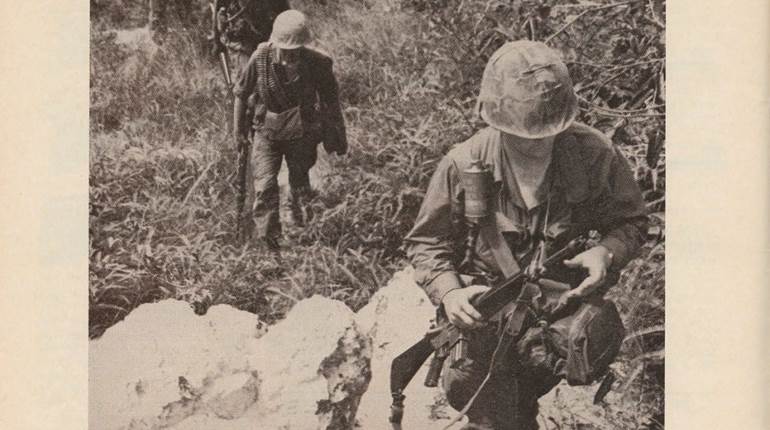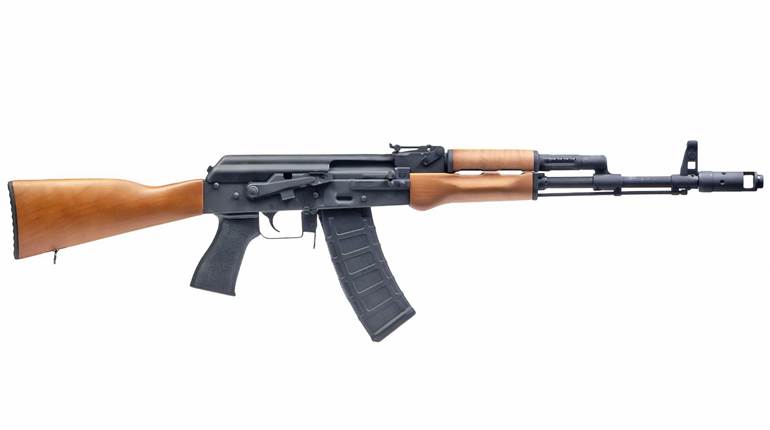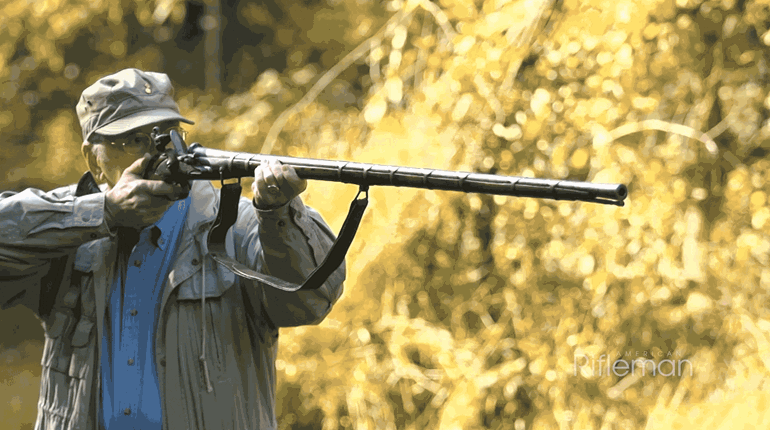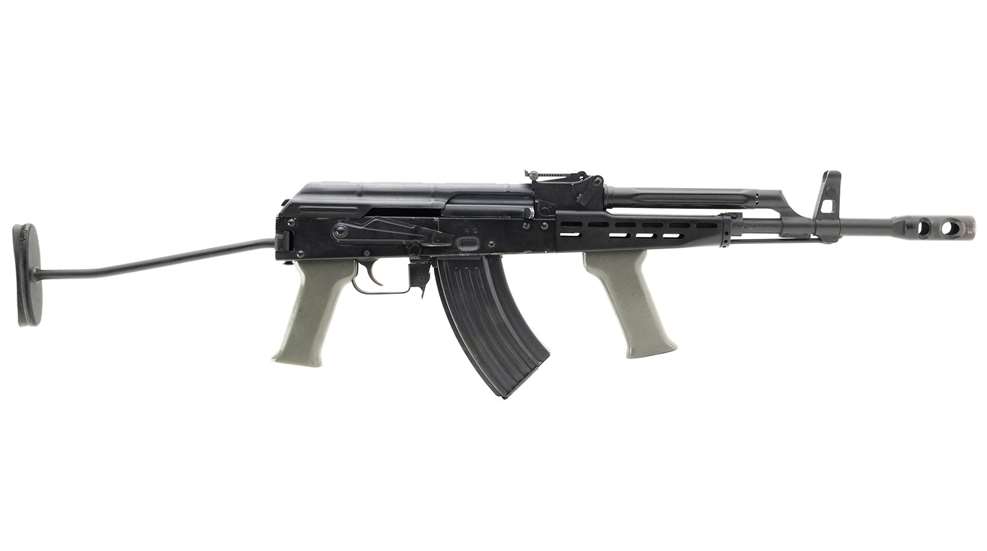
Afghanistan shares an 86-mile-long border with Uzbekistan in Balkh Province along the Amu Darya River, about 50 miles north of Mazar-i-Sharif. At the town of Hayātān, on the Afghan side, a 2,600-foot-long bridge stretches across the river to the Uzbek side, and it is the only border crossing between the two countries as well as the only bridge in the region capable of accommodating both rail and road traffic.
The bridge was built in 1982 by the Soviet Union at the height of the Soviet–Afghan War, to provide a logistical supply line leading into the friendly territory of what was, at the time, the Uzbek Soviet Socialist Republic. The Russians imagined that the structure would bring about a speedy end to the war, while simultaneously promoting a stronger relationship with Afghanistan, so they called it the “Friendship Bridge,” which is the name that it is ironically known by to this day.
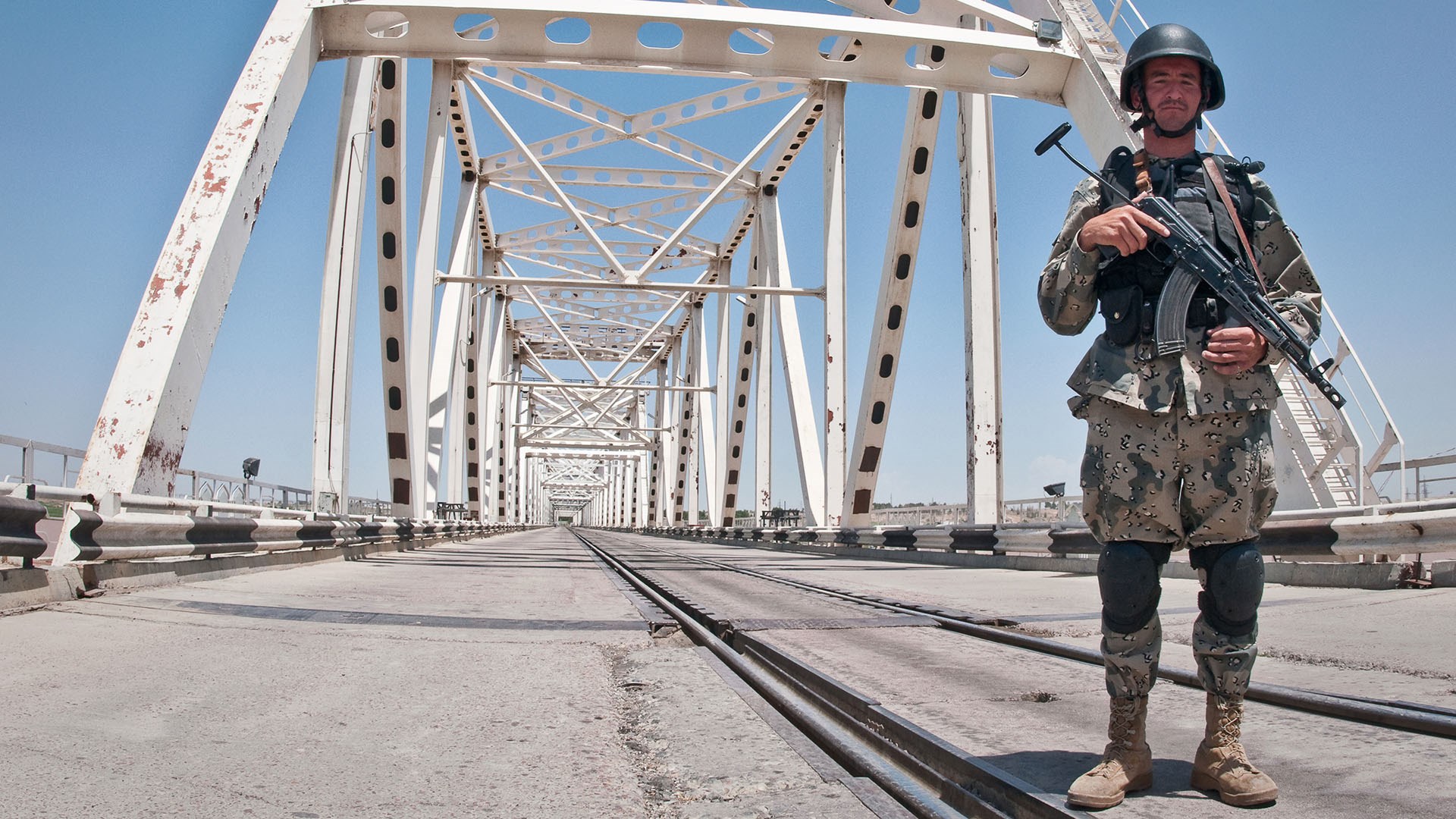 BALKH PROVINCE, Afghanistan (May 27, 2010) —An Afghan Border Policeman armed with an FÉG AMD-65 stands watch on the Freedom Bridge crossing the Amu Darya River. On Feb. 15, 1989, the last Soviet troops to withdraw from Afghanistan crossed the bridge into the, then, Uzbek Soviet Socialist Republic. The bridge now carries rail and vehicular traffic and is the only border crossing between Afghanistan and Uzbekistan. (U.S. Navy photo by Petty Officer 1st Class Mark O’Donald/Released)
BALKH PROVINCE, Afghanistan (May 27, 2010) —An Afghan Border Policeman armed with an FÉG AMD-65 stands watch on the Freedom Bridge crossing the Amu Darya River. On Feb. 15, 1989, the last Soviet troops to withdraw from Afghanistan crossed the bridge into the, then, Uzbek Soviet Socialist Republic. The bridge now carries rail and vehicular traffic and is the only border crossing between Afghanistan and Uzbekistan. (U.S. Navy photo by Petty Officer 1st Class Mark O’Donald/Released)
When one final column of armored fighting vehicles crossed the “Friendship Bridge” on Feb. 15, 1989, the moment marked the end of the Soviet military’s presence in Afghanistan and a turning point in the Cold War. What happened on the bridge that day ultimately became symbolic of the collapse of the Soviet Union at a time when the future, particularly Afghanistan’s, briefly looked optimistic.
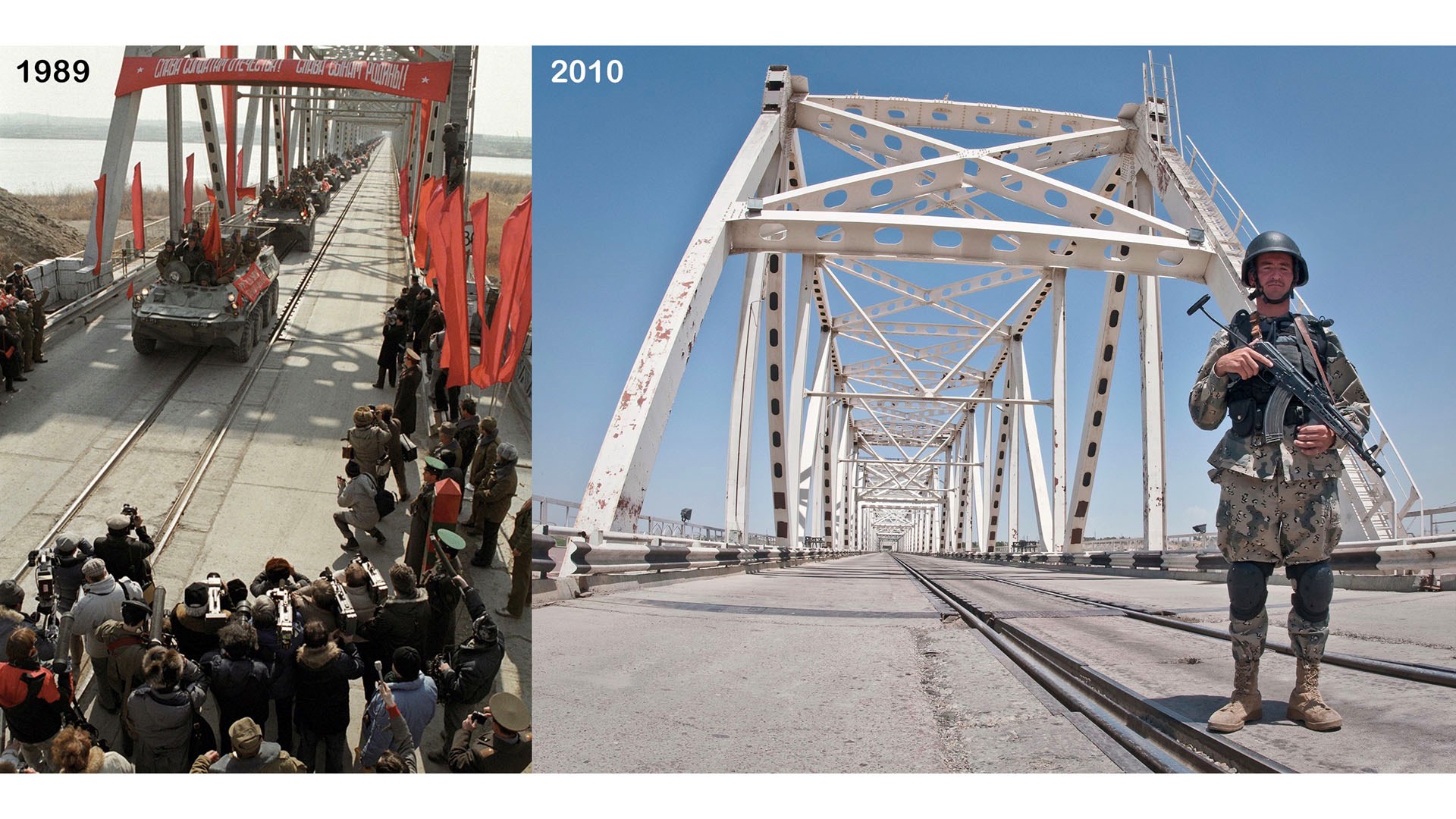 “Then and now” comparison of the “Freedom Bridge” over the Amu Darya River showing Feb. 15, 1989 and May 27, 2010 (7,771 days or 21 years, 3 months, 12 days later).
“Then and now” comparison of the “Freedom Bridge” over the Amu Darya River showing Feb. 15, 1989 and May 27, 2010 (7,771 days or 21 years, 3 months, 12 days later).
But the withdrawal of Soviet forces marked instead the beginning of the Afghan Civil War, which would lead in turn to the rise of the Taliban and ultimately a jihadist network named Al-Qaeda. In the aftermath of Sept. 11, 2001, the NATO-led International Security Assistance Force (ISAF) began a military mission in Afghanistan that would eventually lead to the establishment of 700 military bases in the country – some operated by NATO member nations and some by Afghan National Security Forces.
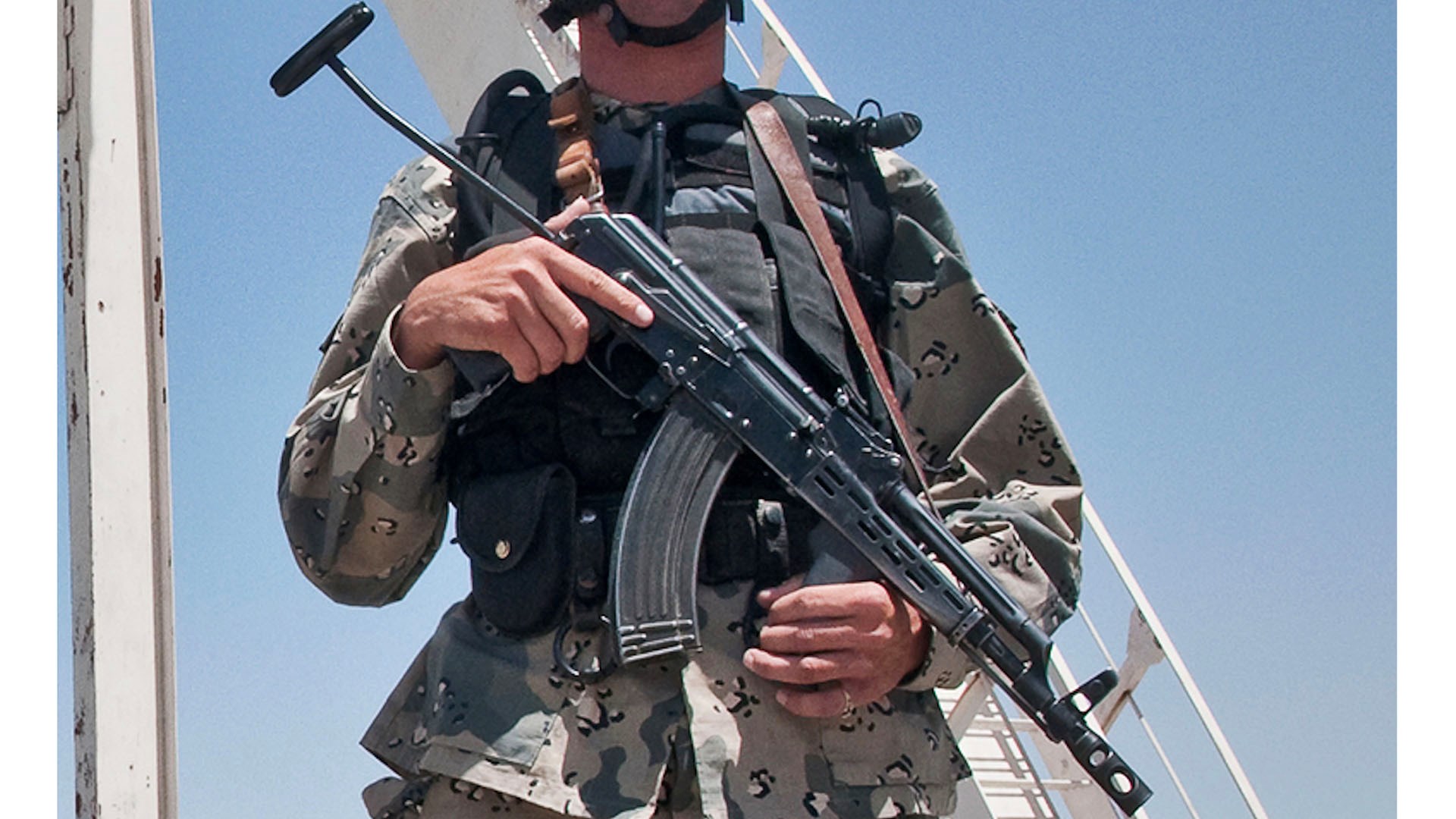 A closer view of the Afghan Border Policeman's FÉG AMD-65 rifle. (U.S. Navy photo by Petty Officer 1st Class Mark O’Donald/Released)
A closer view of the Afghan Border Policeman's FÉG AMD-65 rifle. (U.S. Navy photo by Petty Officer 1st Class Mark O’Donald/Released)
This era brought security troops back to the banks of the Amu Darya River and the old “Friendship Bridge” the Russians left behind back in 1989. On May 27, 2010, 21 years after the final Soviet troops crossed it, a U.S. Navy sailor snapped a photograph of an Afghan Border Policeman standing on the “Friendship Bridge” holding a Kalashnikov. But the gun in the photograph is not Russian, it is Hungarian – specifically an AMD-65.
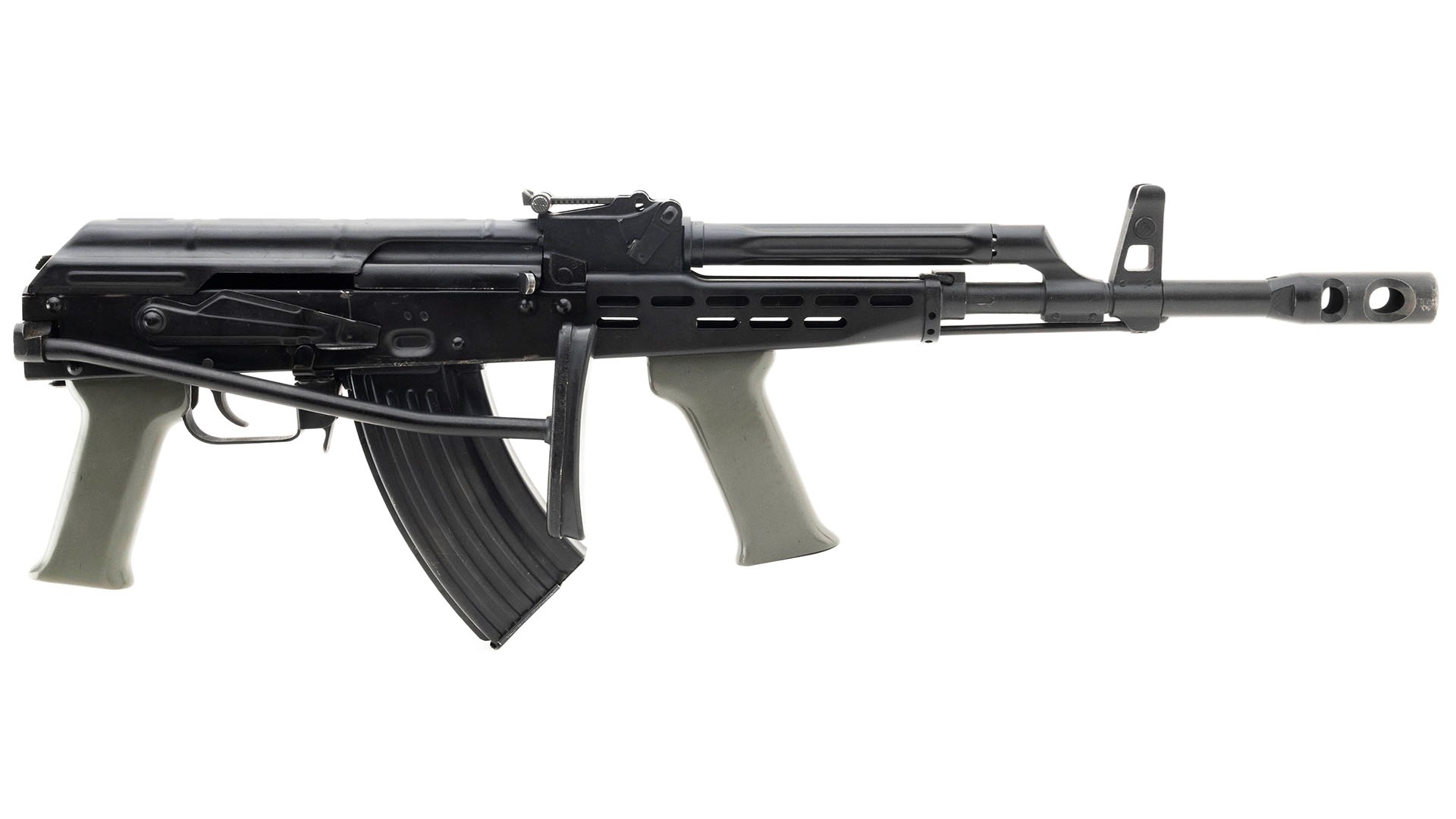 Right side view of TGI SA 2000M S/N EF 8403 H showing the guns 25" length with stock folded. (Photograph by Jeff Hallinan of Collectors Firearms in Houston, Texas)
Right side view of TGI SA 2000M S/N EF 8403 H showing the guns 25" length with stock folded. (Photograph by Jeff Hallinan of Collectors Firearms in Houston, Texas)
This version of the AKM went into production at Fegyver- és Gépgyár (FÉG) in Budapest in 1966 and, as it was intended for paratroopers and mechanized forces, it was equipped with a short barrel and the side-folding stock that gives it a distinct appearance. In a country more closely associated with the Soviet Kalashnikov, this Hungarian version of the rifle ultimately came to be a common sight because, in 2005, the Pentagon procured 84,000 surplus AMD-65s for Afghanistan’s National Security Forces.
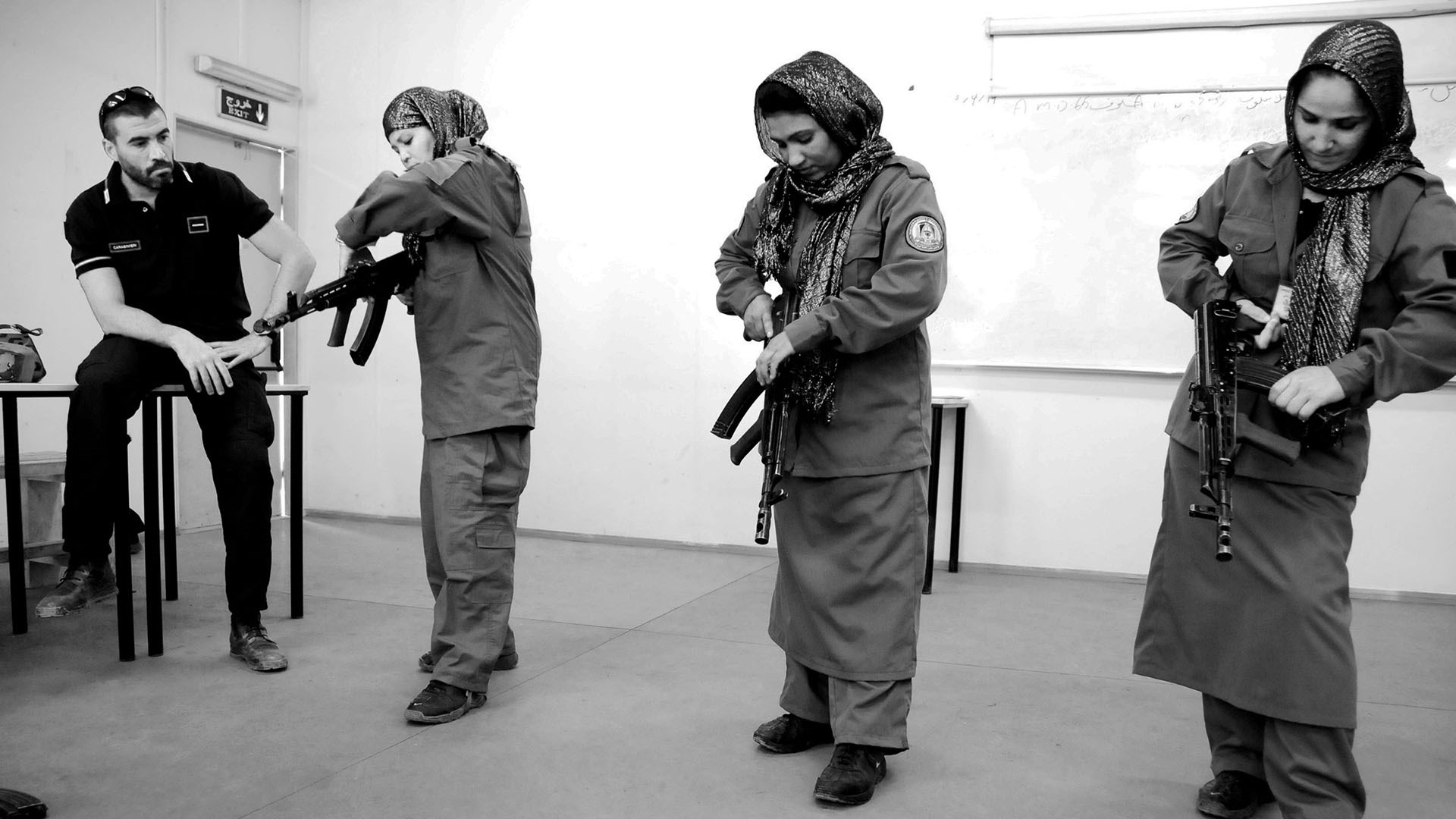 An Italian Carabinieri watches as female Afghan National Police recruits demonstrate how to use the FÉG AMD-65 during an eight-week basic police training course at the Central Training Center in Kabul on Oct. 7, 2010. (U.S. Air Force photo by Staff Sgt. Sarah Brown/RELEASED)
An Italian Carabinieri watches as female Afghan National Police recruits demonstrate how to use the FÉG AMD-65 during an eight-week basic police training course at the Central Training Center in Kabul on Oct. 7, 2010. (U.S. Air Force photo by Staff Sgt. Sarah Brown/RELEASED)
Those guns have trained and armed women and men from the Afghan National Army, the Afghan Local Police and the Afghan National Police, which is why an example could be seen guarding the “Friendship Bridge” in May 2010. From the start, the Global War on Terror has displayed a tendency to bring together strange bedfellows, and that tendency ended-up giving an old Cold Warrior – the AMD-65 – a new purpose that carried it across the threshold of the 21st century and delivered it to the fight against that Taliban.
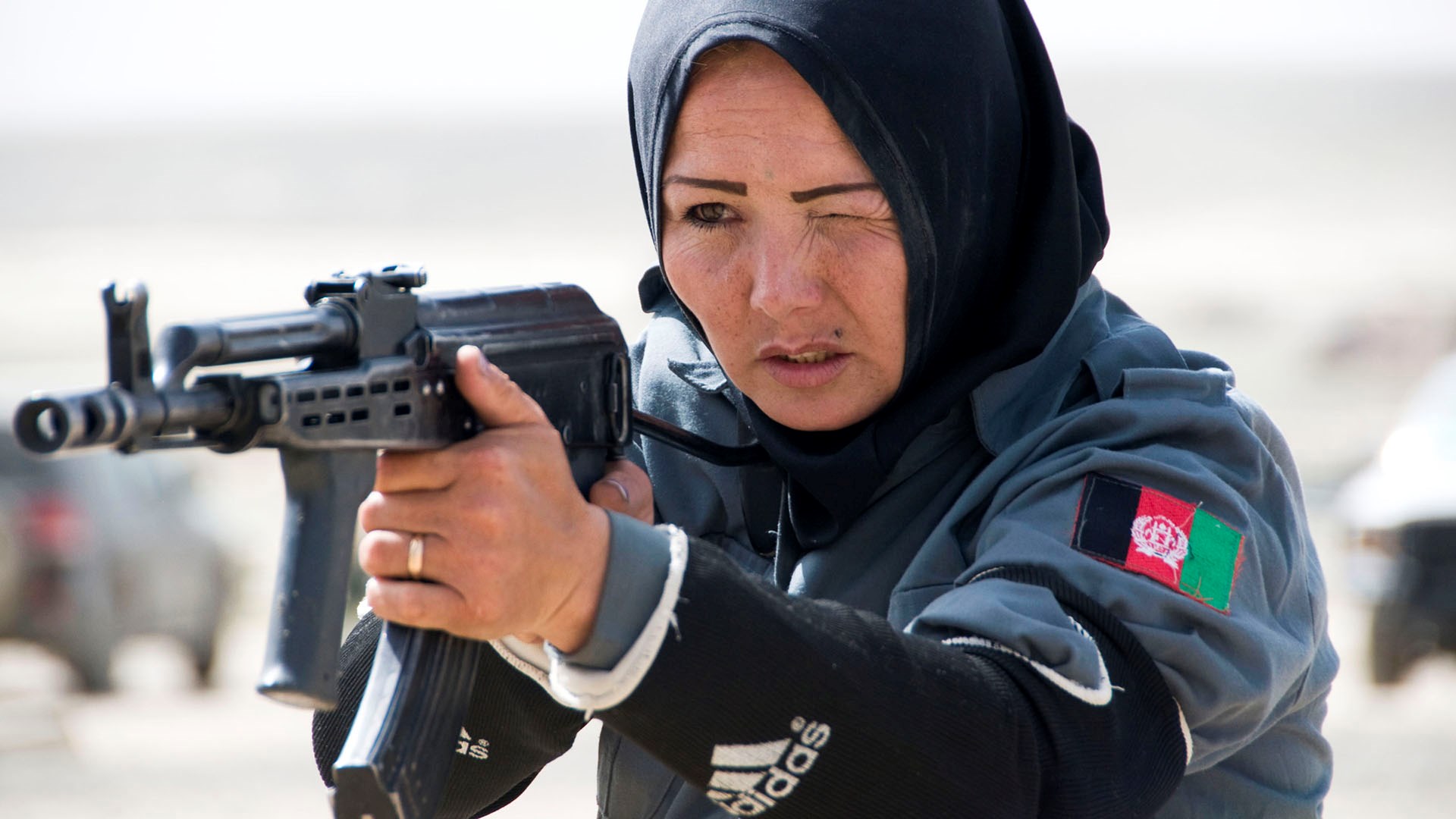 An Afghan National Policewoman qualifies on the FÉG AMD-65 during the tactical training program portion of the police basic training course at Kabul Military Training Center, April 13, 2010. During the eight-week course, trainees learn police-specifics such as penal and traffic codes, use of force and improvised explosive device detection. The course also covers the Afghan constitution, human rights and two weeks on weapons and tactical training. (U.S. Air Force photo by Staff Sgt. Sarah Brown/RELEASED)
An Afghan National Policewoman qualifies on the FÉG AMD-65 during the tactical training program portion of the police basic training course at Kabul Military Training Center, April 13, 2010. During the eight-week course, trainees learn police-specifics such as penal and traffic codes, use of force and improvised explosive device detection. The course also covers the Afghan constitution, human rights and two weeks on weapons and tactical training. (U.S. Air Force photo by Staff Sgt. Sarah Brown/RELEASED)
Hungary’s experience with the Kalashnikov began in 1959, when the Type 3 milled receiver AK-55 in 7.62x39 mm went into production as a joint effort between Danuvia and FÉG. Four years later, FÉG began producing a modernized version designated AKM-63 that was built using a lighter, sheet-metal receiver and a modified sheet-metal lower hand-guard.
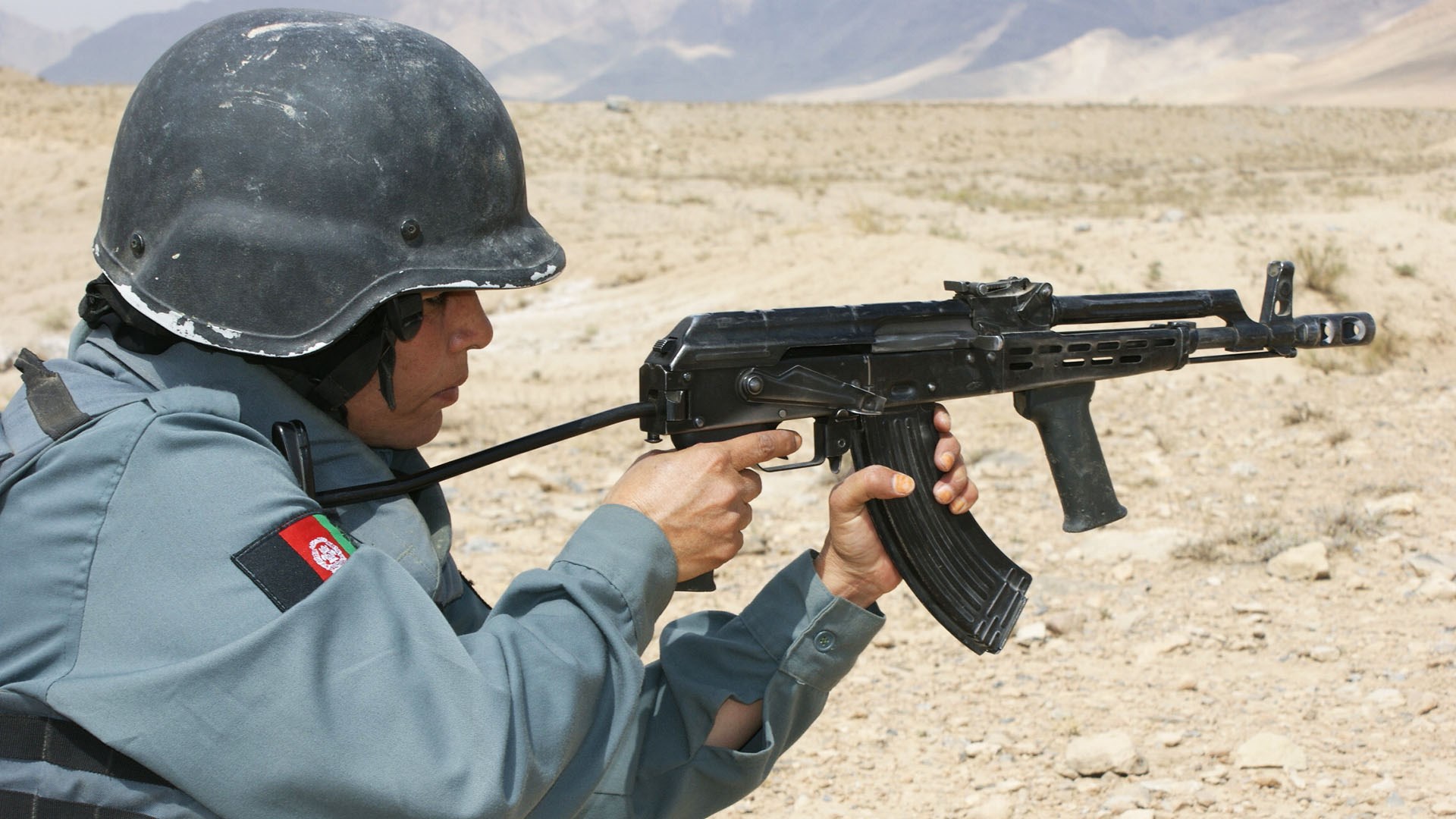 Sept. 29, 2010 - An Afghan uniformed policewoman practices marksmanship techniques with an FÉG AMD-65 at Kabul Military Training Center with help from Italian Carabineri from NATO Training Mission Afghanistan. (U.S. Navy photo by Chief Petty Officer Brian Brannon/RELEASED)
Sept. 29, 2010 - An Afghan uniformed policewoman practices marksmanship techniques with an FÉG AMD-65 at Kabul Military Training Center with help from Italian Carabineri from NATO Training Mission Afghanistan. (U.S. Navy photo by Chief Petty Officer Brian Brannon/RELEASED)
In addition to that, it introduced an angled pistol grip that also served double duty as a vertical foregrip, but other than that, the AKM-63 was identical to the Soviet AKM. At first it used wood furniture, but ultimately FÉG introduced lightweight polymer furniture. While it was a successful design, the gun’s 34" overall length and fixed stock proved to be not entirely ideal for airborne and mechanized operations, so FÉG began to develop a more compact variant.
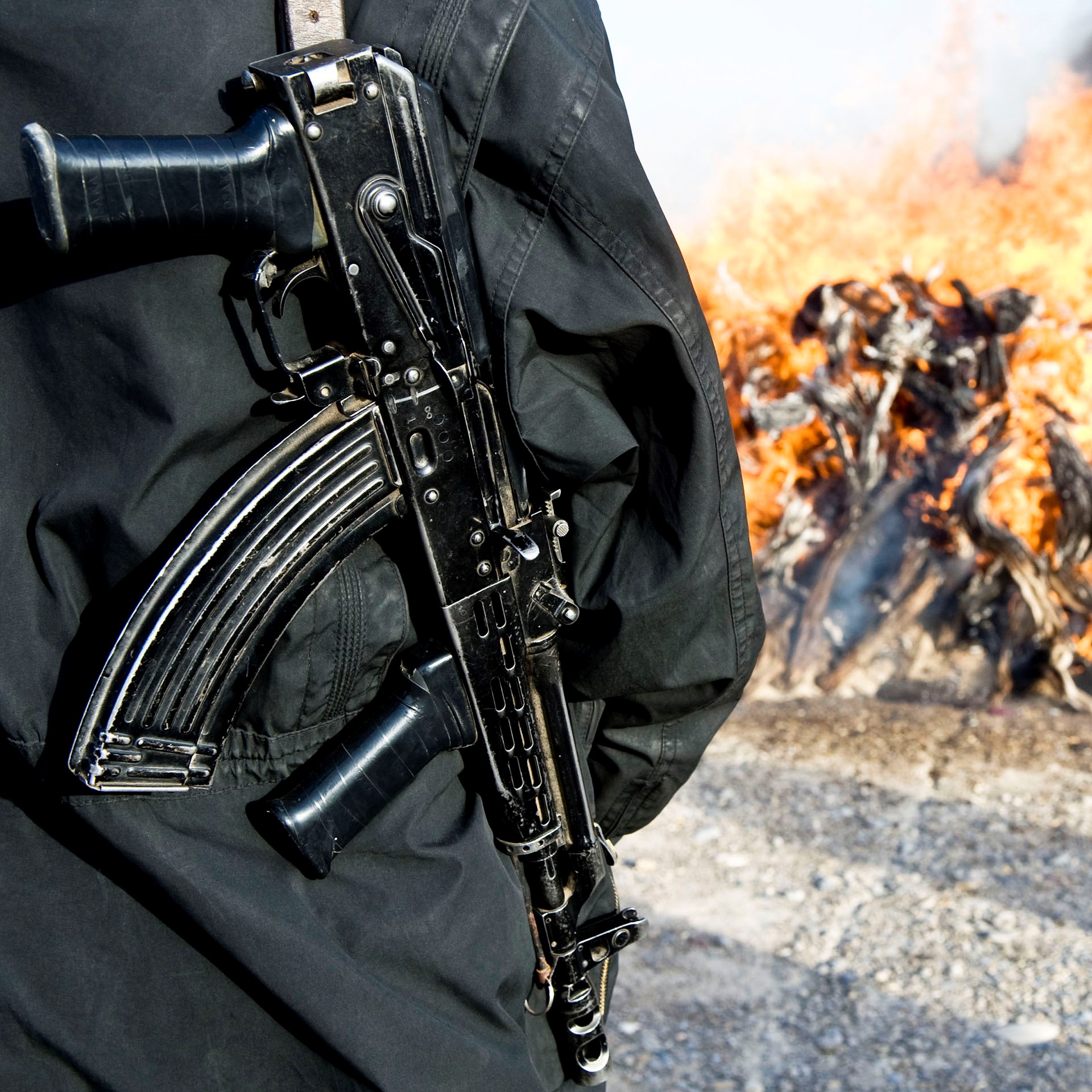 An Afghan National Police officer watches as 18 tons of drugs burn at Lashkar Gah, Afghanistan following successful raids by British and Afghan forces on Feb. 4, 2009. POA (Photo) Dave Husbands - http://www.defenceimagery.mod.uk/fotoweb/fwbin/download.dll/45153802.jpg - Created: 2009-02-04 04:49:58
An Afghan National Police officer watches as 18 tons of drugs burn at Lashkar Gah, Afghanistan following successful raids by British and Afghan forces on Feb. 4, 2009. POA (Photo) Dave Husbands - http://www.defenceimagery.mod.uk/fotoweb/fwbin/download.dll/45153802.jpg - Created: 2009-02-04 04:49:58
The factory’s main engineer, Dr. Károly Zala, started by reducing barrel length from 16-" to 12.5", which also required reducing the length of the gas piston by over an inch and changing the graduations on the tangent rear sight assembly. Whereas the AKM-63’s rear sight graduations reach out to 1,000 meters, the AMD-65’s only go up to 800 meters, reflecting the slightly more modest maximum effective range of the shorter barrel.
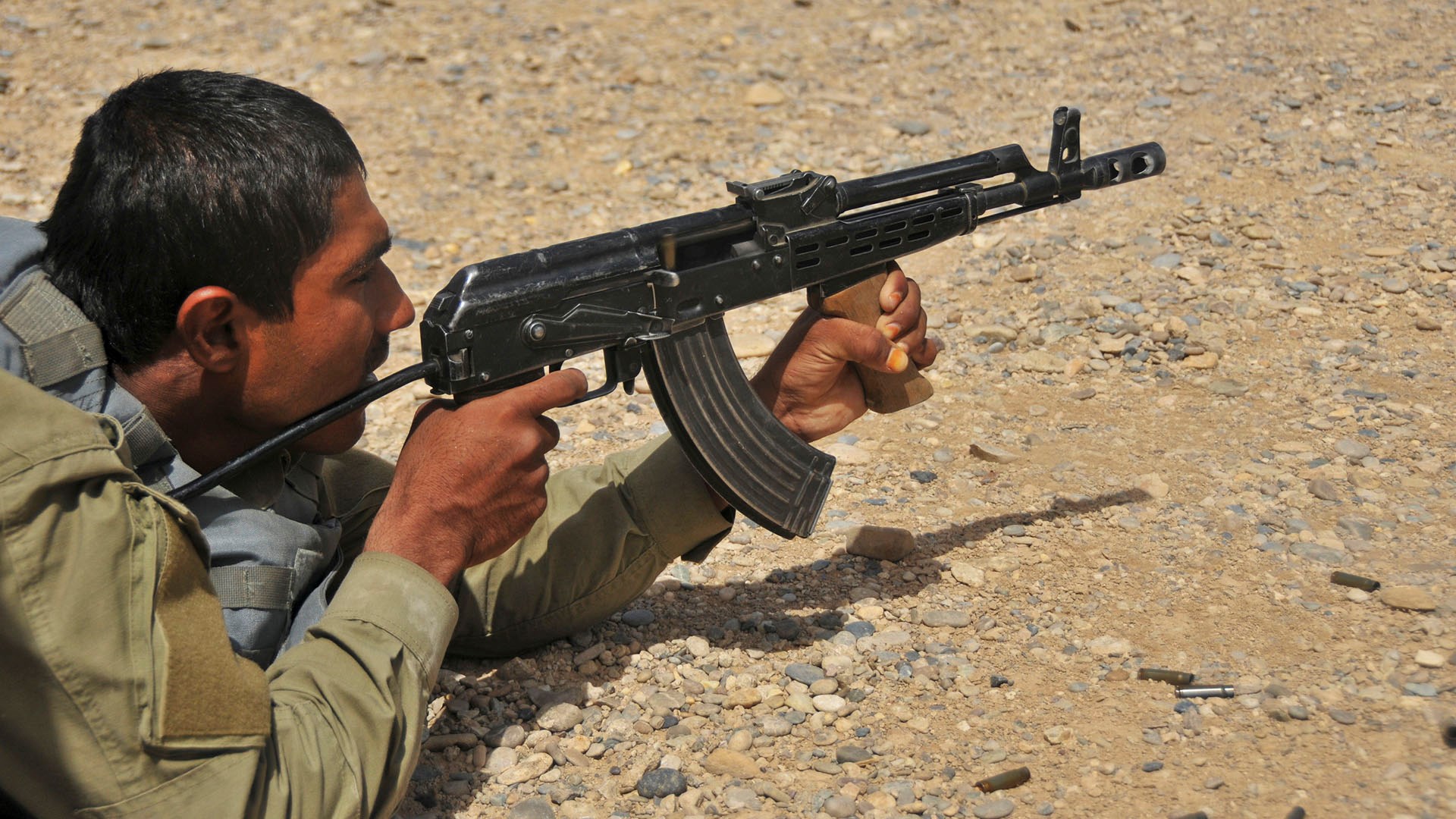 An Afghan Local Police recruit participates in weapons training on a range at Helmand's Regional ALP Training Center in Lashkar Gah district, Helmand province, Afghanistan on June 5, 2013. (U.S. Army photo taken by SPC. Juaquime Wright/RELEASED)
An Afghan Local Police recruit participates in weapons training on a range at Helmand's Regional ALP Training Center in Lashkar Gah district, Helmand province, Afghanistan on June 5, 2013. (U.S. Army photo taken by SPC. Juaquime Wright/RELEASED)
To reduce felt recoil and tame the significant muzzle blast associated with the 12.5" barrel, Dr. Zala designed the thick, two-port muzzle brake that is now such a distinctive feature of the AMD-65’s appearance. The sheet steel receiver of the AKM-63 remained largely unchanged aside from a slightly different rivet pattern and a square cut-out designed to accommodate the modified rear trunnion and the locking mechanism for a 10" side-folding stock with a rubber butt pad.
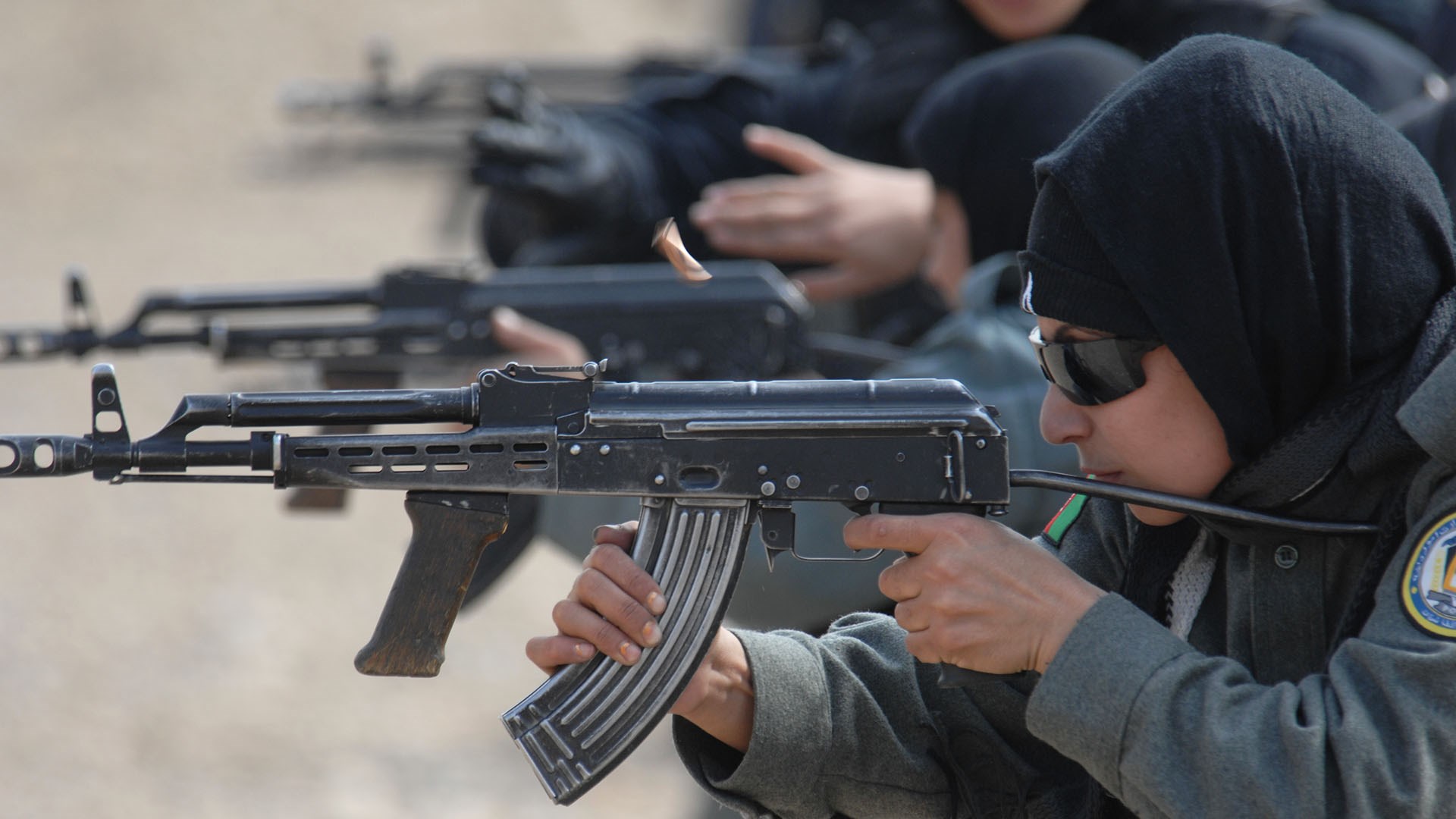 Female Afghan National Army trainees firing FÉG AMD-65 rifles during a field training exercise at the Kabul Military Training Center in Kabul, Afghanistan on Feb. 3, 2010. (U.S. Air Force Photo/Staff Sgt. Larry E. Reid Jr./RELEASED)
Female Afghan National Army trainees firing FÉG AMD-65 rifles during a field training exercise at the Kabul Military Training Center in Kabul, Afghanistan on Feb. 3, 2010. (U.S. Air Force Photo/Staff Sgt. Larry E. Reid Jr./RELEASED)
The redesign produced a Kalashnikov weighing barely over 7 lbs. with an overall length of just 24" with the stock folded. When paired with a shorter 20-round detachable box magazine that was developed a few years earlier for the AKM-63, the AMD-65 gave the Hungarian People's Army exactly what it needed – a lightweight, compact 7.62x39 mm Kalashnikov still capable of delivering a 650 round-per-minute cyclic rate-of-fire.
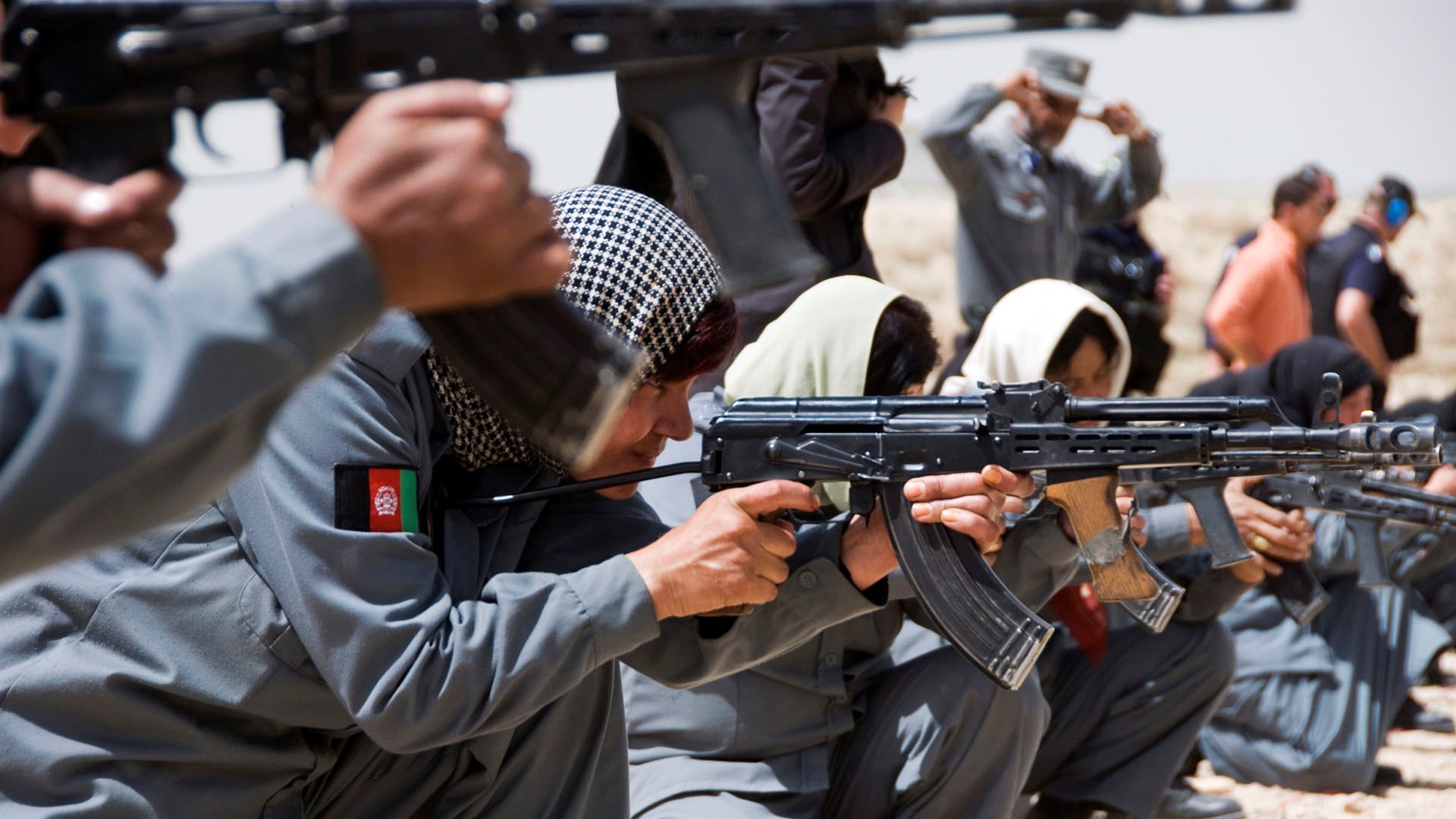 Afghan National Policewomen qualify on the FÉG AMD-65 rifle during the tactical training program portion of the police basic training course at Kabul Military Training Center, April 13, 2010. During the eight-week course, trainees learn police-specifics such as penal and traffic codes, use of force and improvised explosive device detection. The course also covers the Afghan constitution, human rights and two weeks on weapons and tactical training. (U.S. Air Force photo by Staff Sgt. Sarah Brown. 100413-F-1020B-017/RELEASED)
Afghan National Policewomen qualify on the FÉG AMD-65 rifle during the tactical training program portion of the police basic training course at Kabul Military Training Center, April 13, 2010. During the eight-week course, trainees learn police-specifics such as penal and traffic codes, use of force and improvised explosive device detection. The course also covers the Afghan constitution, human rights and two weeks on weapons and tactical training. (U.S. Air Force photo by Staff Sgt. Sarah Brown. 100413-F-1020B-017/RELEASED)
The AMD-65 remained in production at FÉG in Budapest until 1980, at which time it was replaced by the new AK-63, and it remained in Hungarian military service until 2006. Although it never did square off against NATO forces in combat in Europe, which is what it was designed for, it did nevertheless serve in conflict zones around the world. It found its way to Vietnam during the 1970s, Lebanon and Sudan during the Civil Wars there in the 1980s and Croatia during the 1990s.
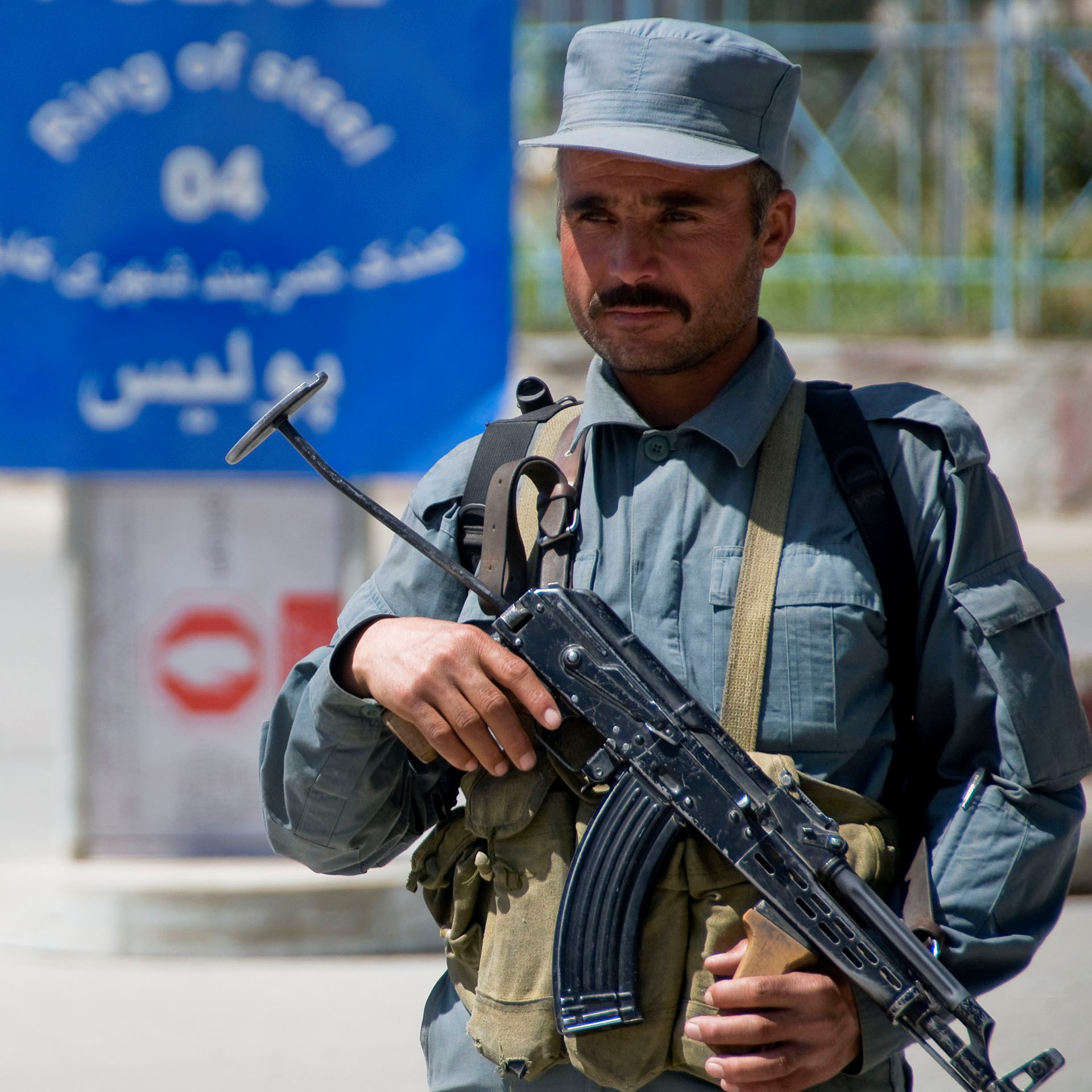 An Afghan National Police officer armed with an FÉG AMD-65 guards checkpoint 4, one of the 25 perimeter security stops established around inner Kabul in June 2010. (U.S. Air Force photo by Staff Sgt. Sarah Brown/RELEASED
An Afghan National Police officer armed with an FÉG AMD-65 guards checkpoint 4, one of the 25 perimeter security stops established around inner Kabul in June 2010. (U.S. Air Force photo by Staff Sgt. Sarah Brown/RELEASED
It has armed Cubans fighting in Angola, the anti-coalition insurgency in Iraq, Tahrir al-Sham militants in Syria and ISIS militants in Egypt. Although it is still likely to be encountered in regional hot spots from the Sinai to the Caucasus, it is nevertheless a relic of the Cold War just like the “Friendship Bridge” over the Amu Darya. Here in the United States, there are both Title 1 and Title 2 versions of the AMD-65 abundantly available.
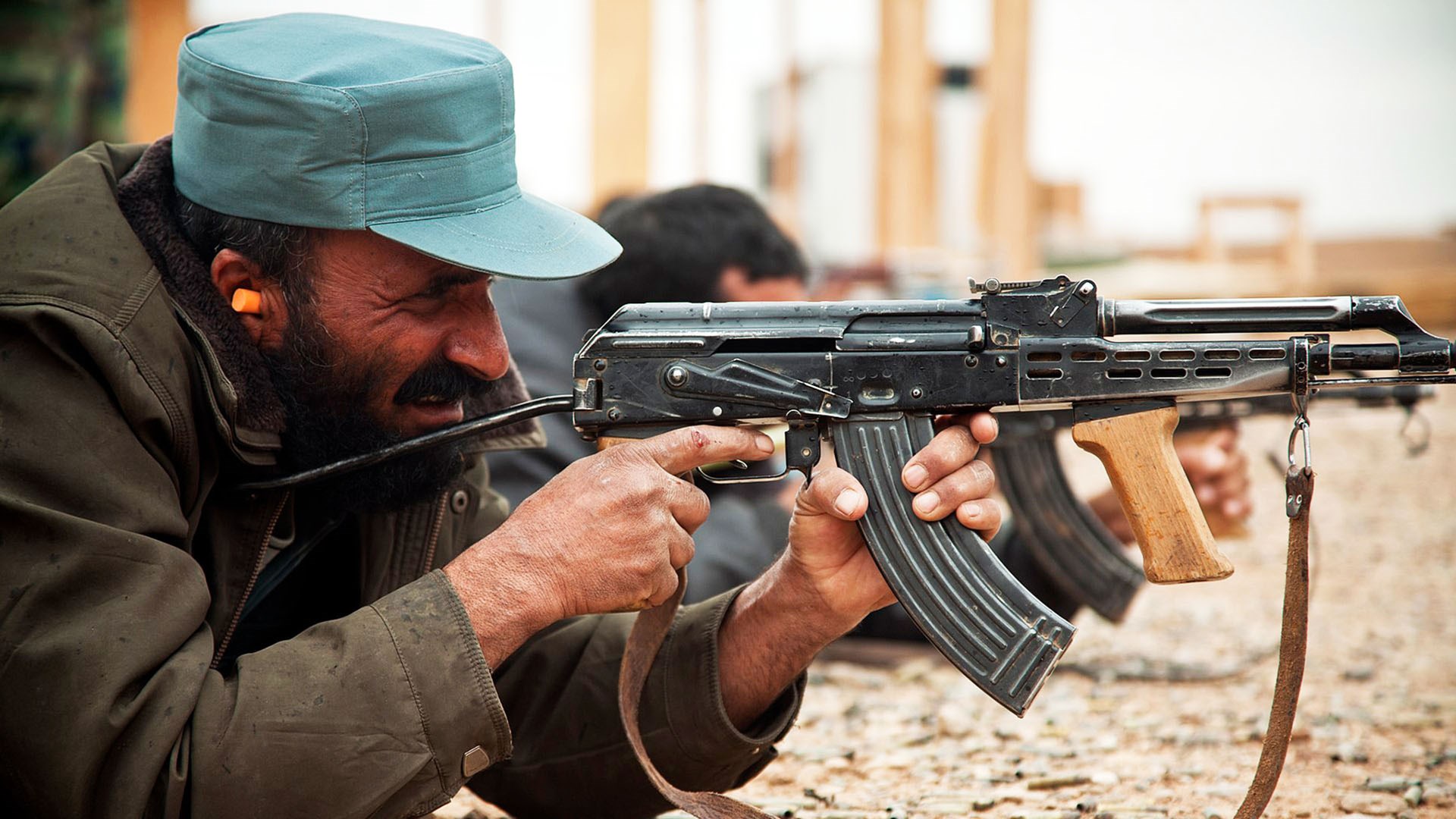 An Afghan National Police officer fires his FÉG AMD-65 during weapons training in Farah province, Afghanistan on Dec. 12, 2012. (U.S. Marine Corps photo by Sgt. Pete Thibodeau/RELEASED)
An Afghan National Police officer fires his FÉG AMD-65 during weapons training in Farah province, Afghanistan on Dec. 12, 2012. (U.S. Marine Corps photo by Sgt. Pete Thibodeau/RELEASED)
The Title 2 versions are either registered short-barreled rifles or select-fire dealer samples, and the more common Title 1 semi-automatic versions are surplus parts kit builds. Among the surplus kit builds, the SA 2000M from the now defunct Tennessee Guns International, Inc. (TGI) holds a special distinction for AK enthusiasts.
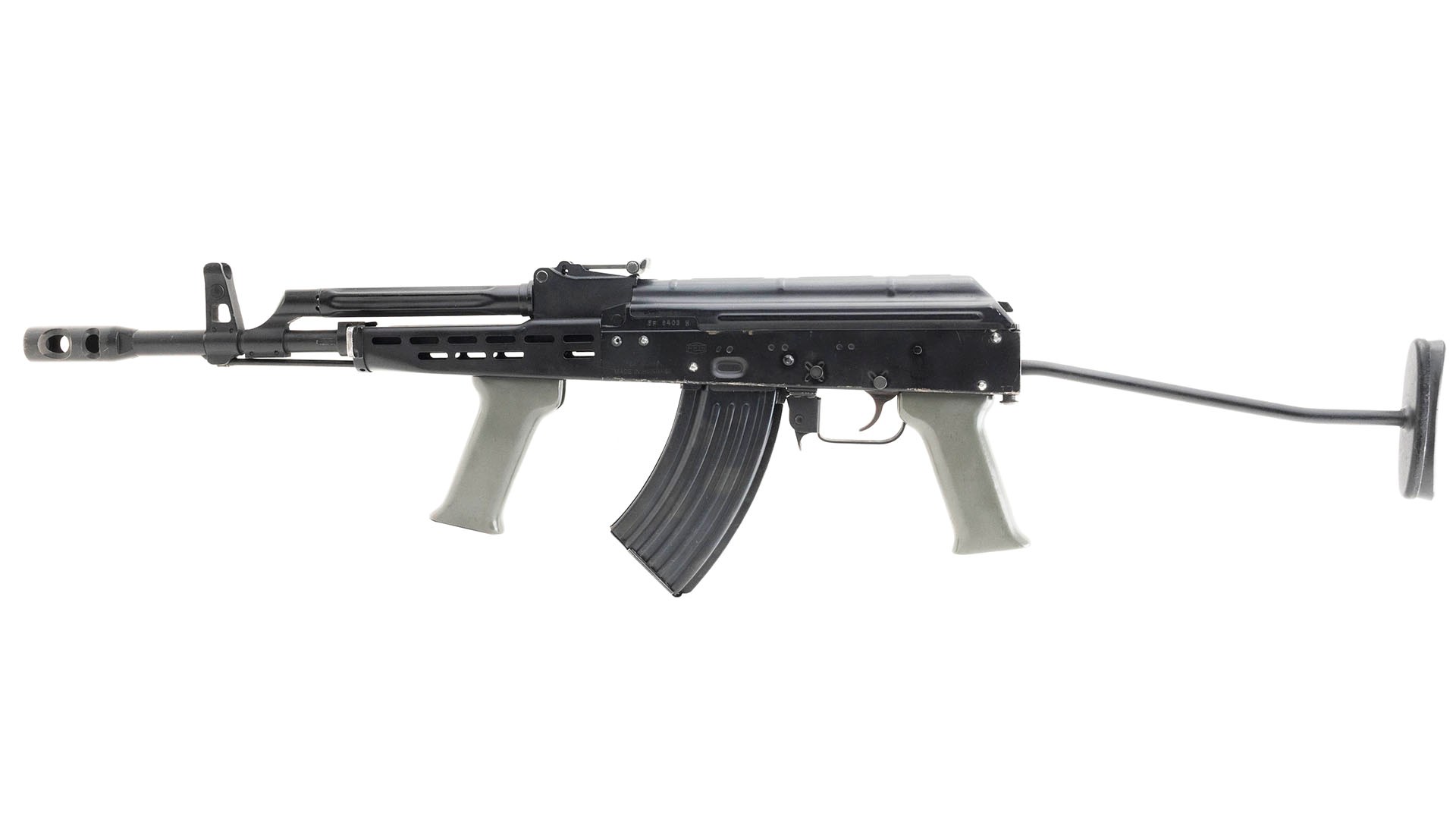 Left side view of TGI SA 2000M S/N EF 8403 H with stock extended and 20-round detachable box magazine. (Photograph by Jeff Hallinan of Collectors Firearms in Houston, Texas)
Left side view of TGI SA 2000M S/N EF 8403 H with stock extended and 20-round detachable box magazine. (Photograph by Jeff Hallinan of Collectors Firearms in Houston, Texas)
Some of the guns with that model designation were imported circa 1999-2000 in post-ban configuration feeding from a single-stack 10-round detachable box magazine. They were assembled using surplus Hungarian AMD-65 kits with military proof marks and original military cold hammer forged/chrome-lined barrels on purpose-built semi-automatic receivers made by FÉG and marked “MADE IN HUNGARY.”
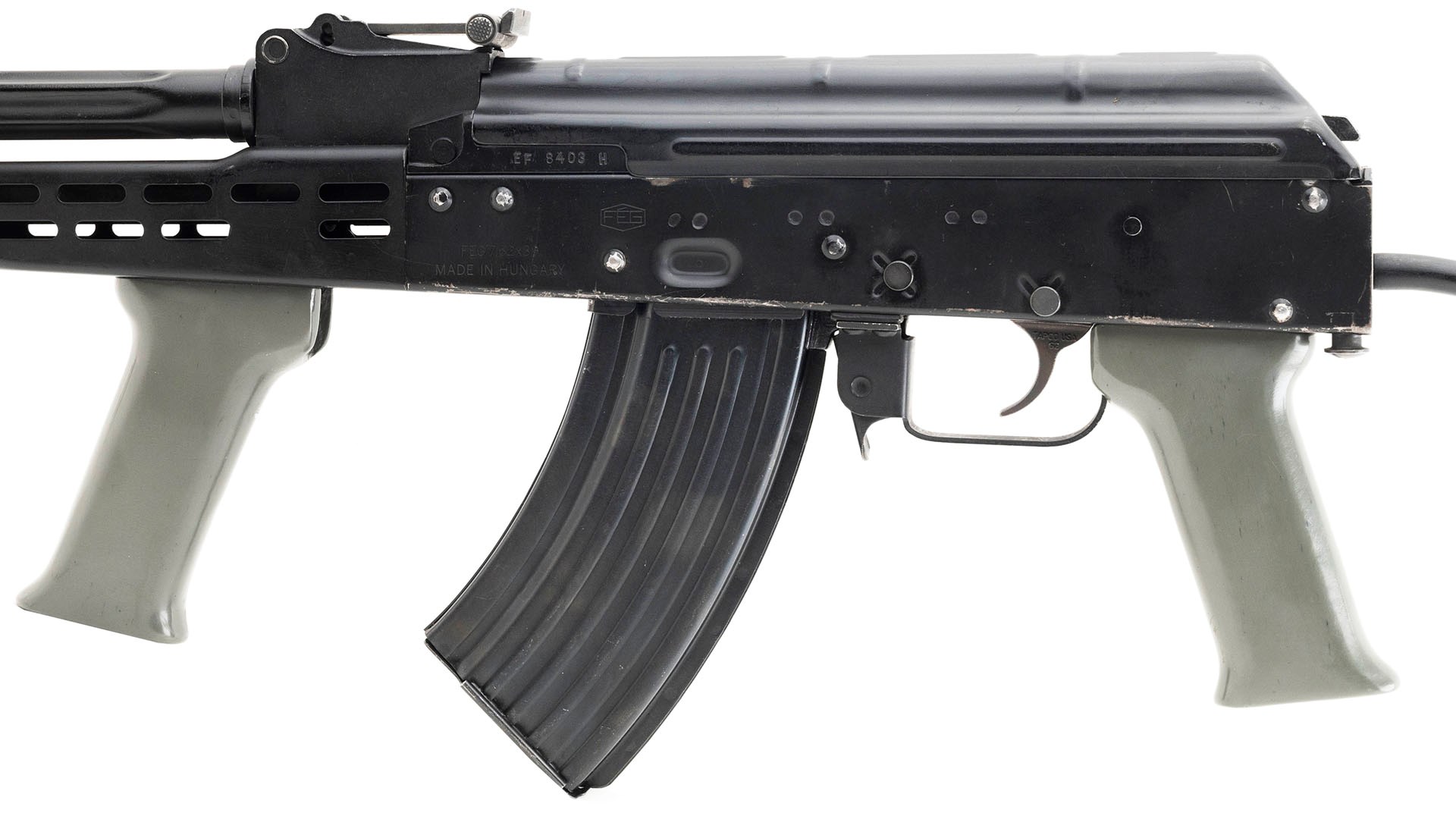 Left side view of TGI SA 2000M S/N EF 8403 H showing the FÉG factory logo as well as the “MADE IN HUNGARY” roll mark. It is noteworthy that the receiver has no serial number on it and that the “EF 8403 H” is on the gun’s trunnion and bolt carrier. (Photograph by Jeff Hallinan of Collectors Firearms in Houston, Texas)
Left side view of TGI SA 2000M S/N EF 8403 H showing the FÉG factory logo as well as the “MADE IN HUNGARY” roll mark. It is noteworthy that the receiver has no serial number on it and that the “EF 8403 H” is on the gun’s trunnion and bolt carrier. (Photograph by Jeff Hallinan of Collectors Firearms in Houston, Texas)
After the Assault Weapons Ban “sunset” in September 2004, TGI converted them to 922(r) compliant semi-automatic rifles complete with the folding stock, a TAPCO U.S.-made hammer, a TAPCO U.S.-made single-claw trigger, and a TAPCO U.S.-made one-piece extended muzzle brake to bring the barrel to the required 16" length. Later examples use a welded 2"threaded barrel extension with the original AMD-65 two-port brake/compensator to accomplish the same thing.
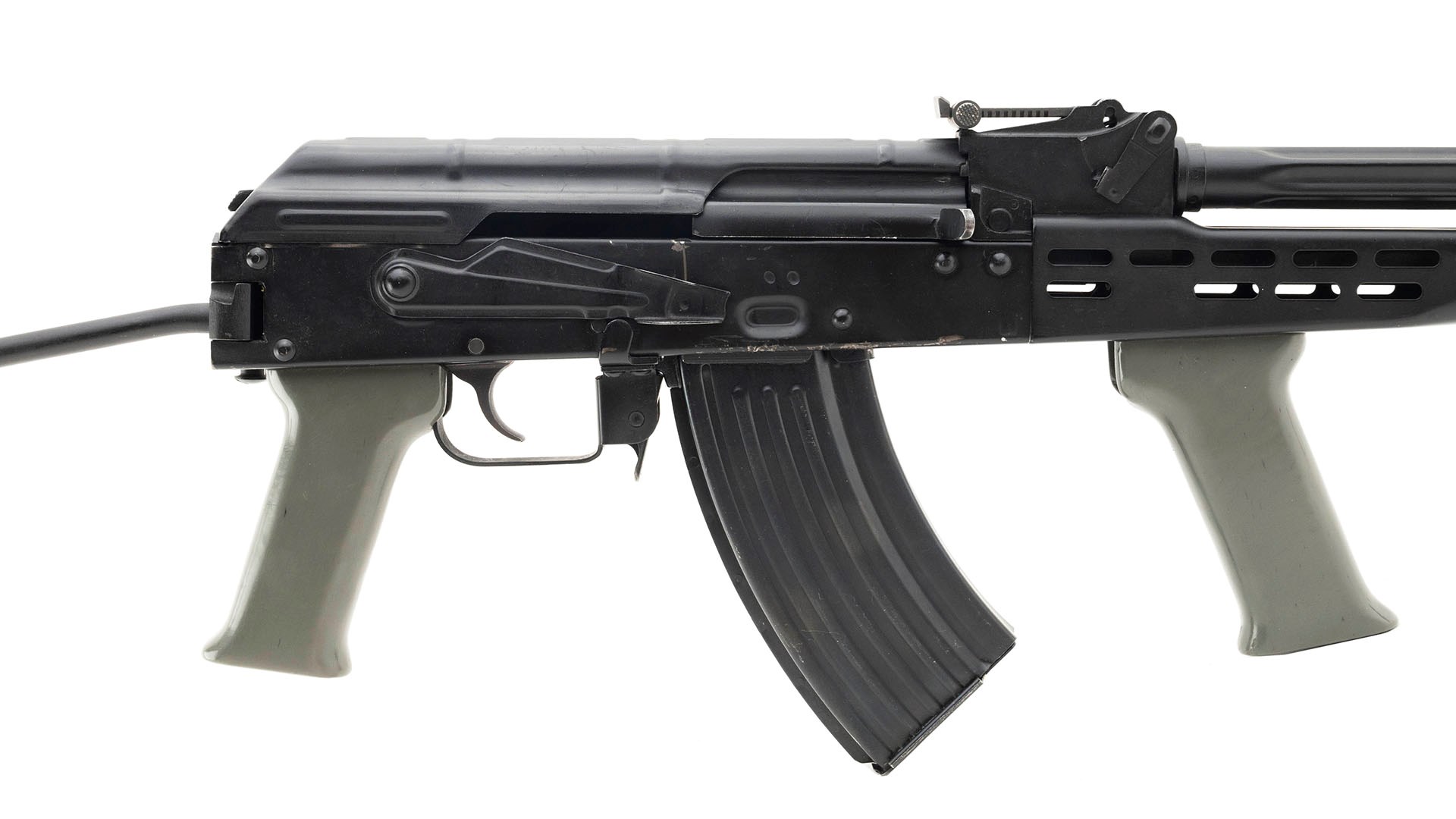 Right side view of TGI SA 2000M S/N EF 8403 H showing the guns sheet metal receiver and sheet metal lower hand-guard. (Photograph by Jeff Hallinan of Collectors Firearms in Houston, Texas)
Right side view of TGI SA 2000M S/N EF 8403 H showing the guns sheet metal receiver and sheet metal lower hand-guard. (Photograph by Jeff Hallinan of Collectors Firearms in Houston, Texas)
TGI also widened the magazine well opening of each gun to accept standard Kalashnikov double-stack magazines. These 922(r) SA 2000M FÉG AMD-65s started selling in 2008 and continued to do so until TGI ceased operation late the following year. They are not particularly common, but they are desirable because they are the closest thing to an actual AMD-65 you can get your hands on without going to Afghanistan.













